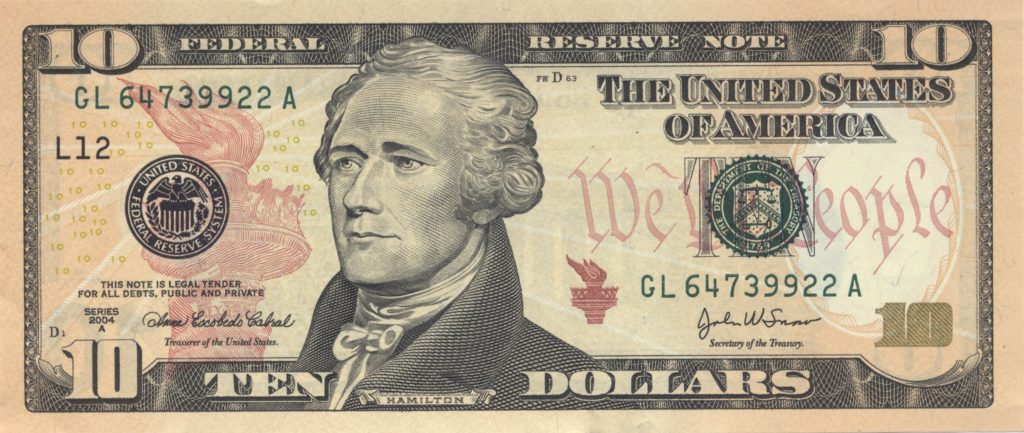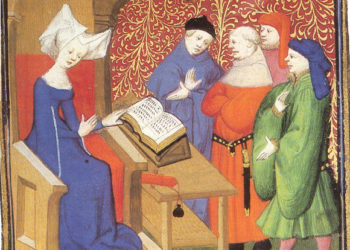Author’s note: Today we’re revisiting a post I wrote almost five years ago, when Hamilton was still a musical, not yet a movie. What a world of difference, as many commenters have remarked. The musical landed during a presidency that seemed to reflect a progressive American trajectory; the movie lands in a very different moment. In the post, I wrote that the extraordinary power of Hamilton was not only the music, or a creative take on the American founding era, but its explicit invocation of history as a mediated process begging for critical engagement. In 2015 I concluded that “the genius of Hamilton doesn’t lie in its historical accuracy, but rather in its willingness to ask what history is, what history does, and how it is made.” I stand by that assessment – if in 2015 I believed this to be so, now I am certain. We have only begin to assess the costs of a history that erases the complexity and violence of the past, of a culture of commemoration in which Confederates rather than enslaved men, women, and children were honored, of an America shorn of its foundation in settler colonialism. Over the last decades, research in communities and among scholars has produced a much deeper and fuller history both of the United States and around the world. But what will we do with that history? I have thoughts, but I’d like to hear yours.
The Scholarly Kitchen might be the only place I haven’t seen Lin-Manuel Miranda’s astonishing musical, Hamilton, discussed, and I figured we needed to fix that. Arguably early American history’s most extraordinary musical moment since 1776, Hamilton raises questions about history and historical practice that reflects what scholars are and aren’t doing.

But perhaps you haven’t been inundated on social media with #Hamilton, #Hamiltunes, #Ham4Ham or the many iterations (#Force4Ham, anyone?), haven’t seen the cast reviewed, interviewed and photographed, or seen the Disney-fied animation, and haven’t had your mental pictures of Thomas Jefferson and George Washington as painted by Gilbert Stuart replaced by the visages of Daveed Diggs and Christopher Jackson. Perhaps your high school freshman didn’t watch Miranda’s 2009 performance at the White House of the Hamilton “mixtape” for his government class. And that same boy, now a senior, isn’t expressing affections a la Jonathan Groff as King George III sending “a fully armed battalion to remind you of my love.” (Yes, he’s getting tickets to Hamilton for his birthday.) Miranda has now won a McArthur genius award, and the George Washington Book (?!) Prize. By early November, more than 16 million downloads of songs from the cast album had been streamed; no wonder YouTube is awash with tribute performances by kids of all ages. All over William & Mary’s campus I hear undergraduate and graduate students humming and hopping to Hamiltunes, and Ron Chernow’s National Book Award-winning biography on which the musical is based is now hard to find in libraries and bookstores alike.
The point is, Hamilton is an extraordinary phenomenon. I can’t keep up with what historians are writing about the musical, let alone the total volume of Hamilton coverage. Now we’re (finally) starting to hear claims about over-saturation and some important critical perspectives on Hamilton are emerging. But with the show planned for national and international stages, the Hamilton train seems unlikely to slow.
I’m no theater critic, but I think anyone would observe that the musical is successful because of the incredible music, including and perhaps especially the dense and complex lyrics, the costumes, choreography, and sets. Marketing choices, including to record a cast album so early in the musical’s Broadway run, have extended its reach. But it’s also striking a chord with audiences because it is about a fraught moment in American history—the founding of the American nation.
There is plenty of historical entertainment around based on the founding era; the past is full of great characters and storylines. On the Revolutionary war alone, last year AMC showed season two of Turn, its series based on the history of a Patriot spy network in New York, and the History Channel offered a fictional account of Boston’s Sons of Liberty. Like Hamilton, these productions distort chronologies and relationships to suit their narrative. But what Hamilton does that these entertainments don’t is to challenge the notion of history itself.
Unlike many academic disciplines, history often seems a bit obvious to the interested public. History is what happened in the past, right? Perhaps we go a bit deeper and reflect on which past is narrated (is history always written by the victors?), and by whom. Job one for history teachers is to explain that primary sources, whether texts or images or objects, require an analysis of how, where, who, and for what purpose they were created before they become useful evidence about the past. I think that elemental point, often overlooked outside of the academy, is at the heart of Hamilton’s success.
I tell my graduate students that one of the primary tasks for early American historians is recovering from the nineteenth century. They always laugh, but there’s a deep truth in this. Like so many scholarly fields of inquiry, history as an academic discipline was shaped in the nineteenth century. The archives we have long depended upon for evidence of the past were largely assembled and catalogued (and some of them, particularly in the south, were destroyed) in the nineteenth century. The early America of the nineteenth century was oriented to the American Revolution and the founding of the nation; it was east coast, and northern; it was white, and it was male.
That’s not the way historians read, research, write, or teach the capacious category of early American history anymore. But still too often this is the story of national origins. Recently I wrote a somewhat discouraging review of Ric Burns’s The Pilgrims (it will post in January). Mostly I lamented that the Pilgrims, a tiny group of migrants with a questionable influence over the course of American history had been given yet another marquee treatment at Thanksgiving. Don’t get me wrong, I like documentaries and like many Burns productions, by Ken Burns or Ric Burns, this one has many fine qualities. It offers some careful historical reconstruction of this tiny group (not even a majority on the Mayflower). But to make a claim as a national origins story, which is how The Pilgrims was framed, a history has to account for itself. It must be self-reflective about why and how it came to be; in the case of the Pilgrim story, it was the emphasis of nineteenth-century New England historians that moved the tale of a small band of religious radicals into the forefront of American history, edging out, for example, the larger (demographically, geographically, culturally, economically, and by so many other measures) histories of slavery and Native American dispossession.
Not every history has to be meta-history, but there is a burden to founding histories that Hamilton not only shoulders but embraces. The first and last questions of the musical aim straight at how history is made. Miranda begins Hamilton’s biography asking “How does a bastard, orphan, son of a whore…Grow up to be a hero and a scholar? The ten-dollar Founding Father without a father.” And he ends with a reflection on Eliza Schuyler Hamilton’s role as the curator of her husband’s legacy; she collected his papers, interviewed his colleagues, and worked tirelessly to make sure he was not forgotten. “Who lives, who dies, who tells your story?” though, isn’t just a song about a widow’s sense of responsibility to her spouse’s legacy. It recalls the whole of the founding era. Whose story was told, how and why it was told, is the meta-history here. Hamilton argues that women’s voices are often absent both because they were rarely valued in their own time and the archival remnants marginalize them, that politics is a story that triumphs over other themes, and that the nation’s history has been the story of all stories.
I suspect we will begin to read a volume of critical analyses of Hamilton in the new year, particularly given Miranda’s choice to cast actors of color for all the parts except George III. By raising issues of class, status, race, and slavery implicitly (the casting) and explicitly (lyrics and themes), and then offering an ultimately triumphal narrative about the nation itself, Miranda seems to welcome this engagement. A couple of weeks ago Ta-Nehisi Coates asked in The Atlantic why so many writers sketch a hopeful future from what we know to be an often wretched past. Professional historians, he noted, seem more inclined to face the depressing evidence of past patterns. Too much of Hamilton is fictionalized for us to be comfortable with this as a history of the American Revolution and early nation, hopeful or not. The genius of Hamilton doesn’t lie in its historical accuracy, but rather in its willingness to ask what history is, what it does, and how it is made.
Discussion
3 Thoughts on "Revisiting: Who Lives, Who Dies, Who Tells Our Story: Hamiltunes and the Burden of Founding Histories"
Do you know the story I call Hamilton’s revenge, recounted in Princeton: America’s Campus (Penn State, 2012)? Hamilton applied for admission to Princeton but was turned down after being interviewed by the university’s president, John Witherspoon. Later, during the Battle of Princeton, Hamilton was in charge of an artillery battalion and, when some British soldiers took refuge in Nassau Hall, he ordered his soldiers to fire cannonballs into Nassau Hall. (Hamilton had to settle for going to King’s College, which we know today as Columbia University.)
Concepts of historiography and perspective also change, or evolve, over time. Outside our field, few are aware of the emergence of “social” history to complement “political” history, though I’ve made a point of mentioning this in books. Deconstructionism has also influenced this, and not always for the better.
The way Hamilton’s life has been considered, or reconsidered, is a good example of this trend begun during the middle of the 20th century. The life of Christopher Columbus is another.
I’d like to send to Karin Wulf a 2-page article titled “Introduction of Time in History” published in Nov.09, 2018 in Peer Reviewed Journal of Forensic & Genetic Sciences.
Sincerely,
Patrice F Dassonville
Cannes – France



